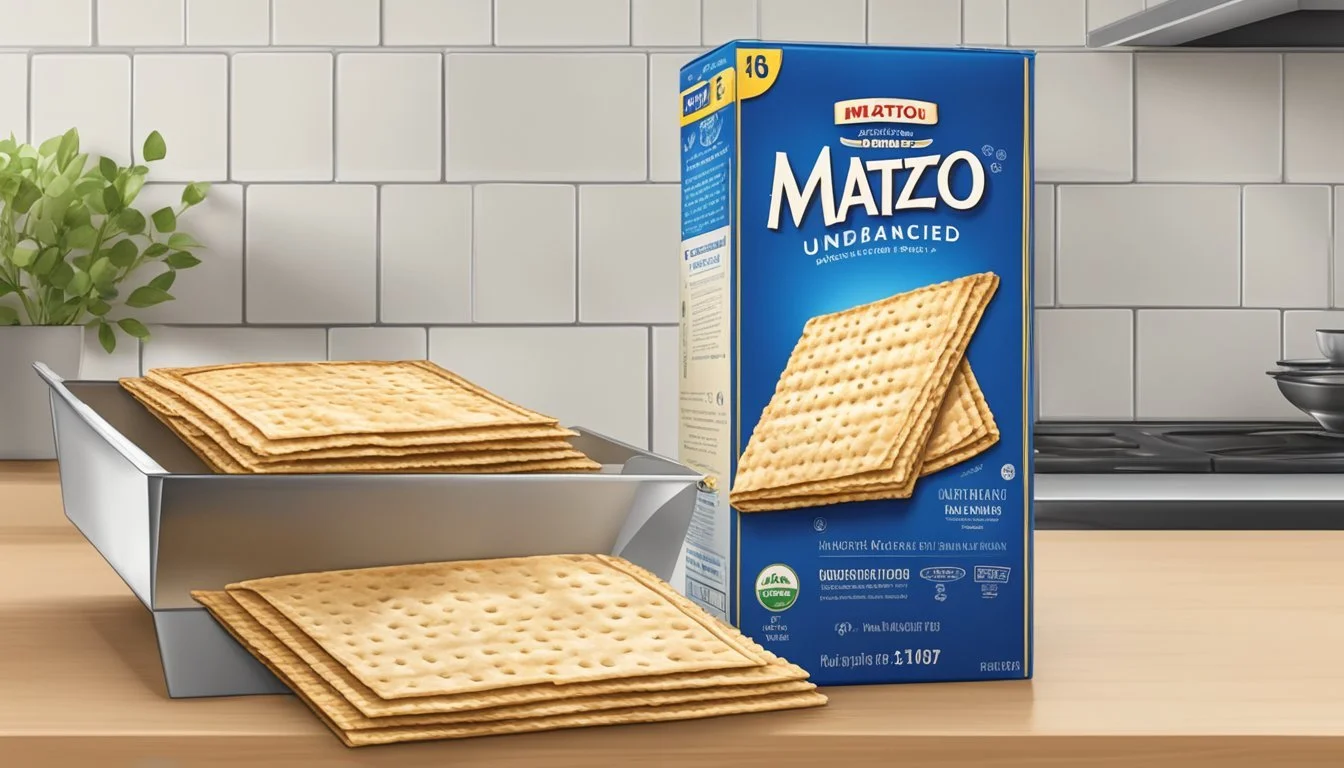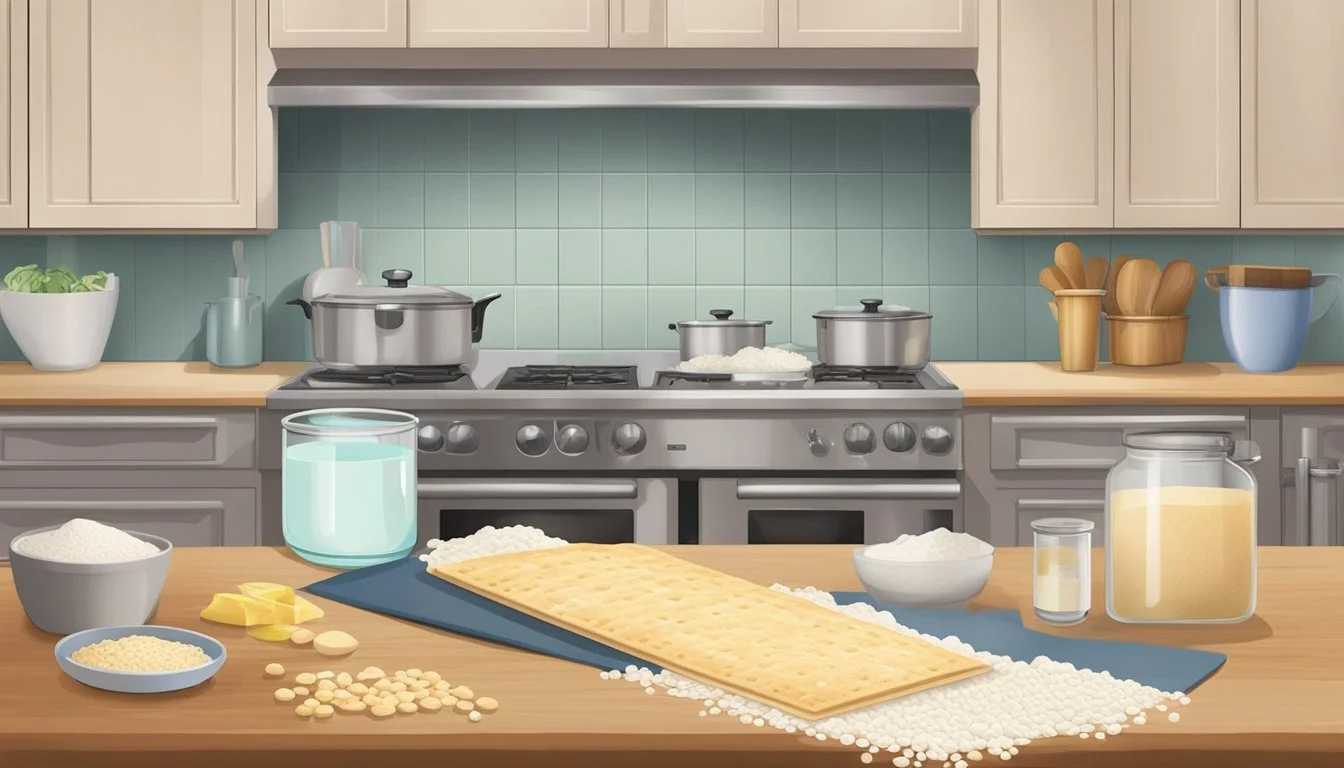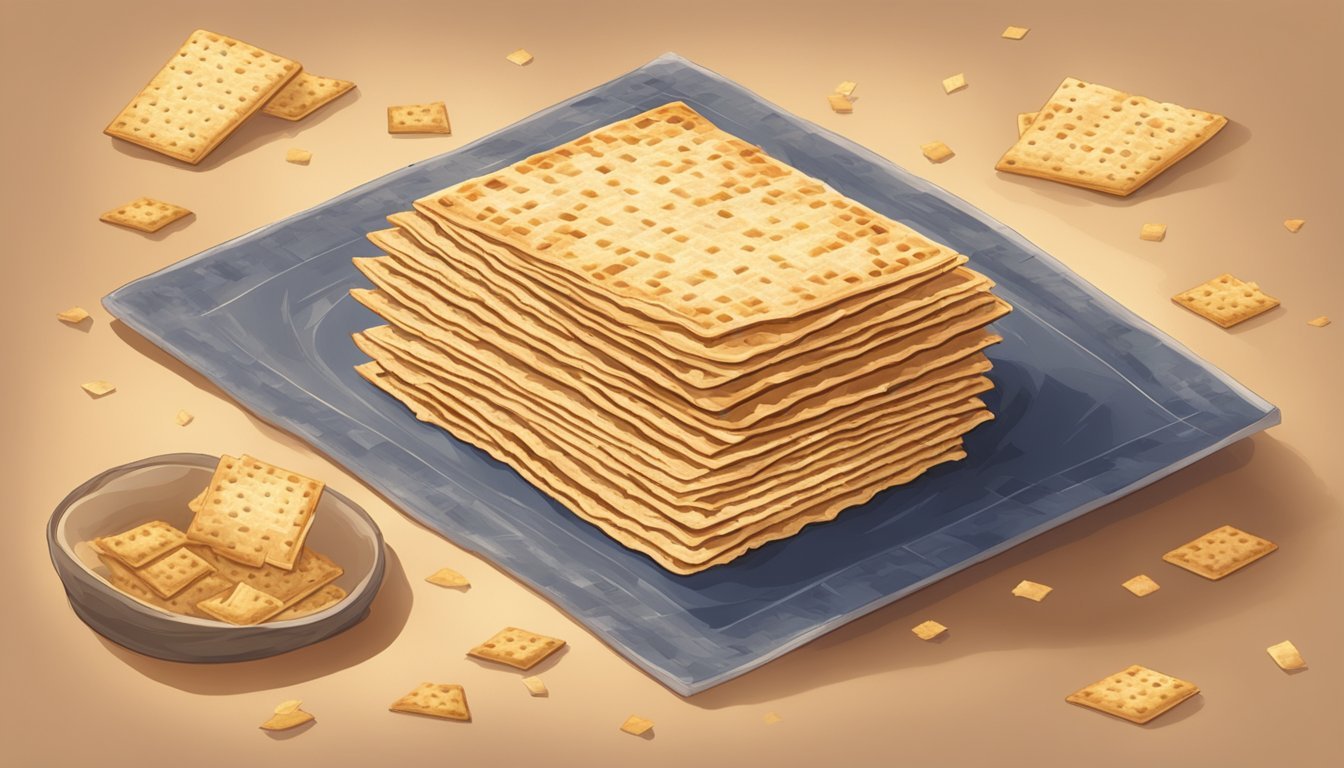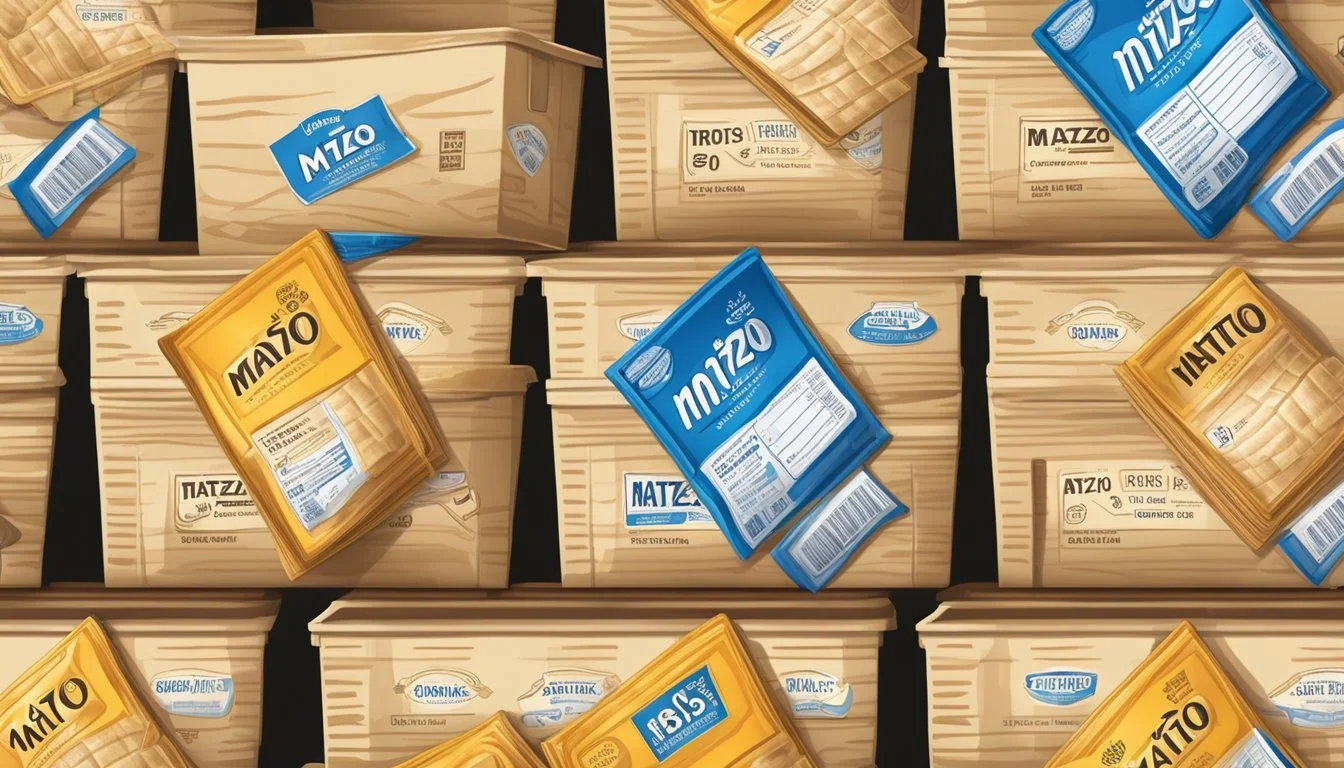How Long Do Matzo Last?
Shelf Life and Storage Tips
Matzo, also known as matzah or matza, is a type of unleavened bread (how long does bread last?) traditionally consumed during the Jewish festival of Passover. According to Jewish law, matzo must be made from one of five grains: wheat, barley, spelt (how long does spelt last?), rye, or oat. Its significance during Passover stems from the Biblical story of the Exodus, where the Israelites left Egypt in haste and did not have time to allow their bread to rise. As a result, matzo serves not only as a food item during the eight days of Passover but also as a potent symbol of freedom and perseverance.
The shelf life of matzo is a topic of interest to those who observe Passover and to consumers who enjoy matzo as a year-round snack. Typically, when stored properly in a cool, dry place, matzo can last for a considerable amount of time. Factors affecting its longevity include the packaging, storage conditions, and whether the matzo has been opened. Unopened matzo retains its freshness longer, especially when kept in its original packaging which is designed to keep out moisture and pests. Opened matzo, on the other hand, requires a bit more care to maintain its quality and prevent staleness.
Understanding Matzo
Matzo, also known as matzah or matza, is a traditional unleavened flatbread that is a cornerstone of Jewish cuisine, particularly during Passover. The bread is made simply from flour and water, with no leavening agents; this simplicity signifies the haste with which the Israelites fled Egypt, not having time to allow their bread to rise.
Key Characteristics of Matzo:
Ingredients: Typically, only plain flour and water
Leavening: None, to maintain its status as unleavened bread
The process of making matzo is time-sensitive. Jewish law specifies that not more than 18 minutes can pass from the time the flour is mixed with water until the matzo is fully baked; this ensures the dough does not begin to rise, adhering strictly to Passover's prohibitions against leavened bread.
For a product to be considered kosher for Passover, it must be made under strict guidelines. These regulations certify that the bread has not come into contact with any grains or leavening agents (chametz) that are forbidden during the Passover holiday.
Matzo is appreciated for its crisp texture and mild, understated flavor, often described as bland. It serves as both a cultural symbol and a versatile component in various recipes, from simple spreads to complex dishes involving broken matzo or matzo meal.
Kosher Considerations for Matzo Flour Type Water Baking Duration
In essence, matzo holds both religious significance and practical importance during Passover while being enjoyed in various forms all year round.
Storing Matzo
Proper storage extends the shelf life of matzo and maintains its crisp texture. It involves keeping matzo in a dry, cool environment, and using airtight containers when opened to protect from moisture and humidity.
Dry Storage
Matzo should be kept in a cool, dry pantry or cupboard, away from direct sunlight or heat sources. Unopened packages will maintain freshness within these conditions. To further protect the integrity of the matzo:
Original Packaging: Retain matzo in its original packaging until ready to use.
Airtight Containers: Transfer any leftover matzo into airtight containers to prevent exposure to air and moisture.
Refrigerating Matzo
Although not typically necessary for unopened packs, refrigeration can be beneficial in certain situations:
High Humidity: In areas with high humidity, storing matzo in the refrigerator can help prevent it from becoming soggy.
Airtight Containers: If refrigerating, wrap matzo in plastic wrap and then place it inside an airtight container to avoid absorbing odors or moisture from the refrigerator.
Freezing Matzo
For long-term storage, freezing is an effective method to preserve the quality of matzo past the standard pantry shelf life:
Airtight Containers: Use airtight containers or resealable freezer bags to protect matzo from freezer burn.
Thawing: To thaw, matzo should be removed from the freezer and allowed to come to room temperature, still sealed in the airtight container, to prevent condensation from softening it.
Matzo Shelf Life
Matzo, also known as matzah or matza, is an unleavened bread traditionally used during the Jewish festival of Passover. Its shelf life varies based on several factors, including packaging and storage conditions.
Unopened Matzo:
Expiration Date: The packaging often includes an expiration date, which should be adhered to for optimal freshness.
Packaging: It typically comes in sealed packaging, aiding in longevity.
Storage Conditions:
Ideal Conditions: Cool, dry places away from direct sunlight will extend its shelf life.
Airtight Containers: Storing in airtight containers after opening can help maintain quality.
Opened Matzo:
To prevent staleness, opened matzo should be wrapped properly and stored in airtight containers.
State Storage Method Expected Quality Unopened Pantry Fresh up to the expiration date Opened Airtight Container Remains fresh if sealed properly
Matzos can become stale if exposed to air for an extended period. Even when stale, they are typically safe to consume but may have an altered texture and taste.
Quality:
The quality of matzo is best preserved by keeping it in its original packaging until use.
Matzos are free from ingredients that spoil easily, such as fat, which contributes to their extended shelf life compared to regular bread.
In summary, by observing the expiration date and employing proper storage techniques, consumers can ensure the freshness and quality of their matzo.
Signs of Spoilage
When assessing whether matzo has spoiled, one should look for clear indicators which typically include changes in appearance, texture, and odor.
Appearance: The presence of mold is a definitive sign of spoilage. Mold may manifest as fuzzy, discolored spots that can appear in green, white, or black. If mold is observed on any part of the matzo, it should not be consumed.
Texture: Matzo should have a crisp, dry texture. A soft or chewy texture indicates moisture has compromised its quality, which could lead to mold formation.
Odor: A stale or off-putting smell is often indicative that matzo is no longer suitable for consumption. While matzo may not have a strong odor when fresh, any sour or musty odors are signs that it has spoiled.
Sensory Attribute Description Action Appearance Presence of mold, discoloration Discard affected matzo Texture Soft, moist, or chewy texture Assess for other spoilage signs Odor Unusual, sour, or musty smell Do not consume
To conclude, matzo, like many other dry food products, maintains its quality if stored properly. However, it is susceptible to environmental factors that may lead to spoilage. If there are any indications of mold, or if the matzo exhibits an unusual texture or odor, it is best to err on the side of caution and not consume the product.
Extending Matzo's Freshness
Proper storage is essential to maintain the freshness of matzo for an extended period. Ideally, matzo should be kept in a cool, dry place away from direct sunlight and moisture. To ensure optimal longevity, it is advisable to store them in an airtight container or resealable plastic bag which guards against humidity and other contaminants.
Freezing matzo can significantly extend its shelf life. When freezing, one should:
Wrap the matzo in aluminum foil or plastic wrap.
Place the wrapped matzo in a freezer bag to provide a double layer of protection against freezer burn.
Expel as much air as possible from the freezer bag before sealing it.
Label the bag with the current date for future reference.
Freezing is particularly effective for homemade matzo and matzo balls. Matzo balls should be stored in airtight containers or tightly sealed freezer bags. They can be separated by parchment or wax paper to prevent sticking. When properly stored, homemade matzo can last for approximately 2 to 3 weeks at room temperature, and significantly longer when frozen.
For best results, one should thaw frozen matzo at room temperature before consumption. It is crucial to avoid reheating them in a microwave or oven after freezing, as this can lead to moisture buildup and a soggy texture. By following these guidelines, individuals can enjoy fresh matzo even out of season.
Cooking and Baking with Matzo
Matzo offers a foundation for a variety of culinary uses, from the creation of matzo meal to crafting tender matzo balls for comforting soups. When incorporating matzo into recipes, both the technique and timing are critical to ensure the desired texture and flavor.
Matzo Meal Uses
Matzo meal, derived from ground matzo, serves as a cornerstone for cooking and baking. It is a versatile ingredient that can replace breadcrumbs and is often used in Jewish cuisine. Chefs employ matzo meal to create coatings for fried foods (What wine goes well with fried foods?), binders in meatballs, or as a thickener in soups. Bakers use it for the structure in desserts such as cakes and cookies, ensuring that recipes remain kosher for Passover.
Coating: Use matzo meal for a crispy exterior on chicken or fish.
Binding: Combine with ground meat to make firm meatballs.
Thickening: Add to soups for a subtle densification.
Making Matzo Balls
Matzo balls, a staple in Jewish cooking, particularly during Passover, are made from matzo meal, eggs, fat, and water. They should be mixed until just combined to retain a light texture. Chefs often chill the mixture before forming balls to ensure they keep their shape during cooking. Matzo balls are typically poached in boiling water or directly in soup until they are fluffy and thoroughly cooked. They can then be served fresh or frozen for later use.
Food Safety Tip: Never freeze uncooked matzo balls as it poses a risk; always cook them fully before freezing.
Passover Recipes
Passover recipes that feature matzo put emphasis on traditional practices while allowing for creativity in the kitchen. One must preheat the oven properly when baking with matzo to ensure even cooking. Using a parchment-lined baking sheet can prevent sticking and browning too quickly. Homemade recipes for Passover might include matzo lasagna utilizing sheets of matzo in place of noodles, or sweet treats like chocolate-covered matzo sprinkled with nuts and fruit.
Savory: Layer matzo, cheese, and sauce for a Passover-friendly lasagna.
Sweet: Drizzle melted chocolate over matzo and add toppings for an easy dessert.
Creative Leftover Ideas
After the Passover festivities, one might find themselves with extra matzo. With its cracker-like texture, matzo is versatile and can be repurposed in various recipes. The key is to view matzo as a blank canvas that can take on savory or sweet toppings, or be transformed into something entirely new like passover rolls.
Sweet Matzo Brei: A traditional favorite, matzo is broken into pieces, soaked, then fried with eggs. To enhance the flavor, they can add cinnamon sugar or drizzle with honey for a satisfying breakfast.
Recipe Suggestion:
Break 4 sheets of matzo into small pieces
Soak in warm milk or water until soft
Mix with 2 beaten eggs
Fry until golden; serve with sweet toppings of choice
Matzo Rolls: For those craving something more bread-like, turning matzo into rolls is an excellent solution.
How to Make Matzo Rolls:
Crush matzo until it resembles coarse flour
Combine with water, eggs, and a bit of oil
Shape into rolls and bake until they're slightly browned
Matzo Pizza: Matzo makes for a quick and crispy pizza base.
Simple Pizza Instructions:
Layer a sheet of matzo with tomato sauce
Sprinkle a generous amount of mozzarella and cheddar cheese
Add toppings as desired and bake until the cheese is bubbly
With these ideas, leftover matzo can easily be transformed into delicious dishes, ensuring no waste and providing the joy of cooking even after the holiday ends. These options represent just a fraction of the limitless possibilities afforded by this humble Passover staple.
Matzo During and Beyond Passover
Matzo, the unleavened bread traditionally eaten during Passover, often prompts questions regarding its shelf life and use beyond the holiday. Passover mandates the consumption of matzo as a reminder of the Israelites' hasty exodus from Egypt, leaving no time for the dough to rise.
Typically, commercially produced matzo boxes are marked with the year of production, indicating they are kosher for Passover of that particular year. Providing the matzo is kept dry in its sealed packaging, it remains suitable for consumption for both the Passover seder and throughout the holiday the following year.
For Year-Round Use:
Sealed Matzo: If unopened and stored properly, matzo can be appropriate for eating beyond the immediate Passover for which it was produced.
Opened Matzo: Once opened, matzo should be stored in airtight containers to maintain freshness.
Here is a simple guide to storing matzo:
Storage Condition Duration Unopened, dry, room temp. Good until next Passover Opened, airtight container Several months to a year
Matzo meal, a derivative product of matzo, also shares a similar shelf life and can extend the use of matzo beyond the traditional Passover seder. Consumers find versatility in matzo meal that can be used year-round in various recipes. Careful storage is essential to prevent the matzo from absorbing moisture which would render it unpalatable and not ideal for consumption.
Frequently Asked Questions
Q: What is the shelf life of unopened matzo?
A: Unopened matzo typically lasts for several months. The exact duration depends on the packaging and the storage conditions, but it is generally safe to consume matzo for up to 6-12 months if stored in a cool, dry place.
Q: How does one store opened matzo to maintain its texture and taste?
A: Opened matzo should be stored in an airtight container to protect it from moisture and preserve its crispness. If the matzo becomes soft, toasting can help restore some of the texture.
Q: Can matzo be made gluten-free?
A: Yes, gluten-free matzo is available for those with gluten sensitivities. Instead of traditional wheat flour, it's made with alternative grains like oat or tapioca.
Q: Are there ideal conditions for storing matzo?
A: Matzo should be stored in a cool, dry place away from direct sunlight and heat sources, which helps to maintain its quality and extend its shelf life.
Q: How should matzo meal be stored after opening?
A: After opening, matzo meal should be kept in a tightly sealed container to prevent exposure to air and humidity, ideally in a cool, dry cupboard. Refrigerating matzo meal can extend its freshness.
Q: Can matzo be used in recipes other than unleavened bread?
A: Absolutely. Matzo is versatile and can be ground into matzo meal for matzo balls, used as a crispy flatbread base, or incorporated into various dishes for added texture.
Q: Is it possible to prepare matzo without eggs or dairy?
A: Traditional matzo bread is unleavened and made without eggs, milk, or sugar, keeping it simple with just wheat flour and water, which is then kneaded and rolled out before baking until golden and crispy.










